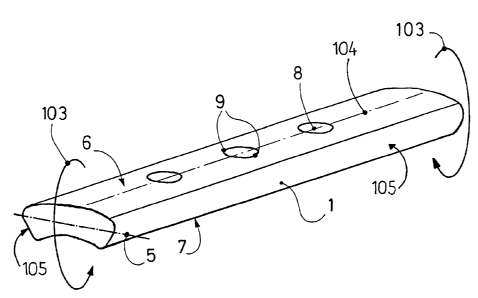Note: Claims are shown in the official language in which they were submitted.
CLAIMS
1. Bone plate with an upper side, a lower side for bone
contact, two longitudinal sides, a longitudinal center line,
a plurality of cylindrical screw holes extending from said
upper to said lower side, said screw holes having curved
edges, an area of said upper side around said screw holes
being depressed with respect to the rest of said upper side,
said depressed area having a curved upper edge, the upper
edge of said depressed area having a curvature, C1, which is
less than 60% of the curvature, C2, of the edge of said
screw hole.
2. Bone plate according to claim 1, wherein said
curvature C1 is smaller than 10% of C2.
3. Bone plate according to claim 1, wherein the depth of
said depressed area gradually decreases toward said
longitudinal center line of the bone plate.
4. Bone plate having an upper surface, a lower surface
for bone contact, a longitudinal center line and a plurality
of cylindrical screw holes extending through the plate, said
screw holes having edges, the upper surface of the plate
being dished out in the area around said screw holes to form
elongated cavities, said cavities having side walls
ascending steeply to said upper surface and sloping end
walls tapering less steeply in the longitudinal direction
from the screw holes upwardly to said upper surface, said
upper surface being uninterrupted between said dished-out
areas.
5. Bone plate according to claim 4, wherein the depth of
said cavities gradually decreases toward said longitudinal
center line of the bone plate.
6. Bone plate having an upper surface, a lower surface
for bone contact, a longitudinal center line and a plurality
of screw holes extending through the plate, said screw holes
having edges, the upper surface of the plate being dished
out in the area around said screw holes to form elongated
cavities having side walls and sloping end walls tapering in
the longitudinal direction from the edges of the screw holes
upwardly to said upper surface, said side walls having a
different slope from the slope of said end walls, said upper
surface being uninterrupted between said cavities and
wherein the depth of said cavities decreases towards said
longitudinal center line.
7. Bone plate according to claim 6, wherein the lower
surface of the bone plate has a concave shape.
8. Bone plate according to claim 7, and comprising
transverse cuts on said lower surface of the bone plate.
9. Bone plate according to claim 6, wherein the depth of
said cavities is in the range of 0.2 to 2.0 mm.
10. Bone plate according to claim 6, wherein the distance
from the edge of said screw holes to said side walls is less
than 1 mm.
11. Bone plate according to claim 6, wherein each of a
plurality of screw holes associated with cavities is a
cylindrical screw hole.
12. Bone plate having an upper surface, a lower surface
for bone contact, a longitudinal center line, and a
plurality of screw holes extending through the plate, said
screw holes having edges, the upper surface of the plate
being dished out in the areas around the screw holes to form
elongated cavities having side walls, said side walls having
edges, and sloping end walls tapering in the longitudinal
direction from the edges of the screw holes upwardly to said
upper surface, said upper surface being uninterrupted
between said cavities, the depth of said cavities being such
that the maximum stress under bending at the edges of said
side walls is approximately equal to the maximum stress at
the edges of said screw holes.
13. Bone plate according to claim 12, wherein said side
walls are generally normal to said upper surface.
14. Bone plate according to claim 12, wherein each of a
plurality of screw holes associated with cavities is a
cylindrical screw hole.
15. Bone plate according to claim 12, wherein the depth
of said cavities gradually decreases toward said
longitudinal center line of the bone plate.
16. Bone plate having an upper surface, a lower surface
for bone contact, a longitudinal center line and a plurality
of cylindrical screw holes extending through the plate, said
screw holes having edges, the upper surface of the plate
being dished out in the area around said screw holes to form
elongated cavities, said cavities having side walls
ascending steeply to said upper surface and the cavity
tapers less steeply adjacent its side walls in the
longitudinal direction from the screw holes upwardly to said
upper surface.
17. Bone plate according to claim 16, wherein the depth
of said cavities gradually decreases toward said
longitudinal center line of the bone plate.
